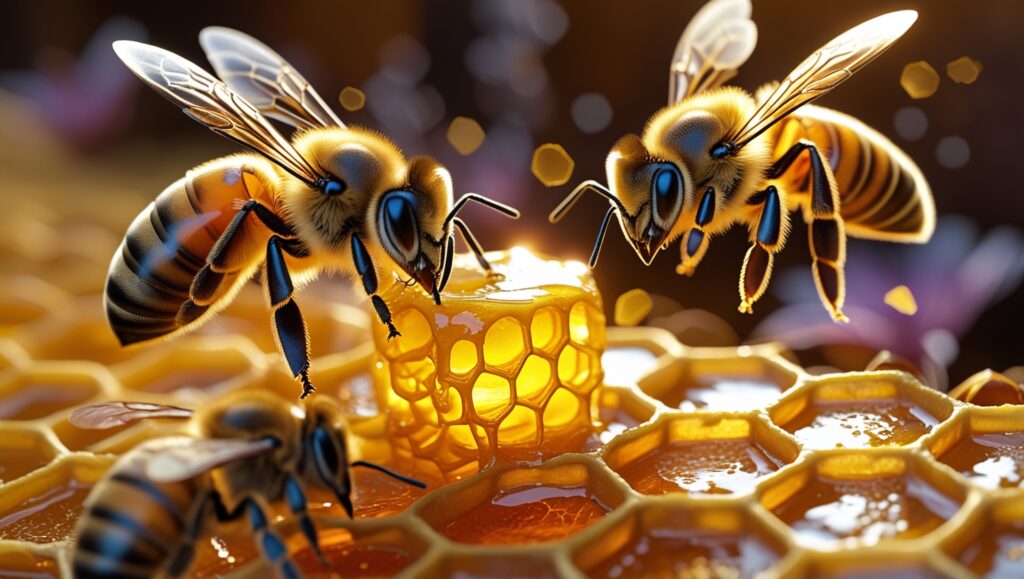When we think of hard work, we often picture people running businesses, building houses, or farming. But did you know that some of the hardest workers in the world are just half an inch long? That’s right—honeybees! These tiny insects are some of nature’s busiest creatures, tirelessly working to pollinate plants, make honey, and keep their colonies thriving. Let’s dive into the incredible world of honeybees and find out how they became nature’s hardest workers.
The Buzz About Bees
Honeybees are social insects, which means they live and work together in colonies. Each colony is like a bustling city with thousands of bees, each having a specific job. There are three main types of bees in a hive: the queen, the workers, and the drones. The queen lays eggs, the workers do almost everything else, and the drones help with reproduction.
Worker bees, all of which are female, are the true heroes of the hive. They’re responsible for gathering nectar and pollen, building and cleaning the hive, feeding the young, and even guarding the colony from intruders. In short, they’re multitasking masters!
Fun Fact #1: A single worker bee produces only about 1/12 of a teaspoon of honey in its lifetime. But together, a hive can produce up to 60 pounds of honey in a year!
The Daily Life of a Worker Bee

From the moment a worker bee hatches, she’s ready to get to work. But her responsibilities change as she ages:
- Cleaning Crew: For the first few days of her life, a worker bee cleans the hive. She ensures that every cell is spotless and ready for storing honey or raising young bees.
- Nurse Bee: Next, she takes on the role of caring for larvae (baby bees). She feeds them a special diet of pollen and nectar, helping them grow strong and healthy.
- Builder Bee: Around her second week of life, the worker bee begins producing wax. She uses this wax to build the honeycomb, where food is stored, and new bees are raised.
- Forager: Finally, in the last stage of her life, the worker bee becomes a forager. She flies out of the hive to collect nectar, pollen, water, and tree resin. This is the most dangerous job, as foraging bees are exposed to predators and harsh weather.
Fun Fact #2: A worker bee can visit up to 5,000 flowers in a single day! Talk about dedication!
Pollination: A Vital Job
One of the most important jobs honeybees do is pollination. When bees visit flowers to collect nectar and pollen, they transfer pollen from one flower to another. This helps plants produce fruits, vegetables, and seeds. Without bees, many of the foods we enjoy, like apples, almonds, and blueberries, wouldn’t exist.
In fact, honeybees are responsible for pollinating about one-third of the food we eat. That means every third bite of food on your plate is thanks to these hardworking insects. Amazing, right?
Fun Fact #3: Honeybees communicate with each other using a “waggle dance.” By wiggling their bodies in specific patterns, they can tell other bees where to find the best flowers.
How Bees Make Honey

Have you ever wondered how honey gets from flowers to your toast? It’s a fascinating process! When a forager bee collects nectar, she stores it in a special part of her body called the honey stomach. Back at the hive, she passes the nectar to another bee, who chews it to break down its sugars. This process is repeated until the nectar turns into honey. The bees then store the honey in the honeycomb and seal it with wax to keep it fresh.
Honey isn’t just food for bees; it’s also their energy source. During the winter, when flowers are scarce, bees survive by eating the honey they’ve worked so hard to make.
Fun Fact #4: Honey never spoils! Archaeologists have found pots of honey in ancient Egyptian tombs that are still edible after thousands of years.
Teamwork Makes the Dream Work
What makes honeybees so successful is their incredible teamwork. Every bee in the colony knows its role and works tirelessly to support the hive. Even the queen, who might seem like she’s just lounging around laying eggs, is essential for keeping the colony alive. Without her, there would be no new bees to replace the old ones.
Worker bees communicate constantly to keep the hive running smoothly. Whether it’s through their waggle dance, pheromones (chemical signals), or simple touch, they’re always sharing information about food sources, threats, and the hive’s needs.
Fun Fact #5: A bee’s wings beat about 200 times per second, creating the familiar buzzing sound we hear. That’s like flapping your arms faster than you can blink!
Challenges for Honeybees

Despite their hard work, honeybees face many challenges. Habitat loss, pesticide use, climate change, and diseases have led to a decline in bee populations worldwide. This is a big problem, not just for bees but for humans too. Without enough bees to pollinate crops, our food supply could be at risk.
Fortunately, people are stepping up to help. Planting bee-friendly flowers, reducing pesticide use, and supporting local beekeepers are just a few ways we can make a difference.
Conclusion
Honeybees might be small, but they’re some of the most important creatures on the planet. From pollinating plants to making honey, their hard work keeps ecosystems healthy and food on our plates. The next time you see a bee buzzing around, take a moment to appreciate its incredible dedication. After all, nature’s hardest workers deserve a little gratitude!



